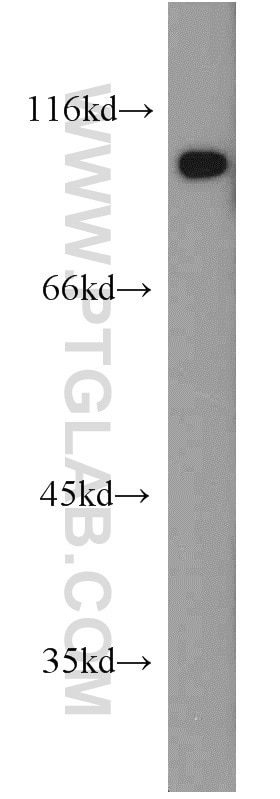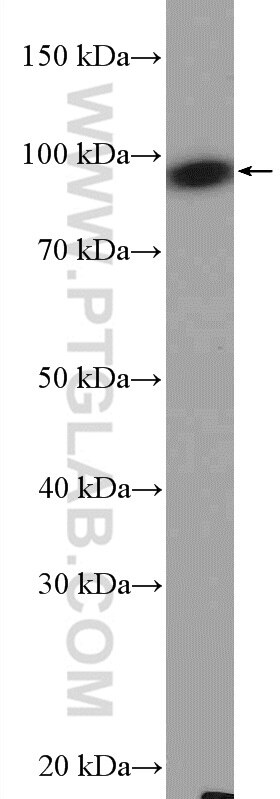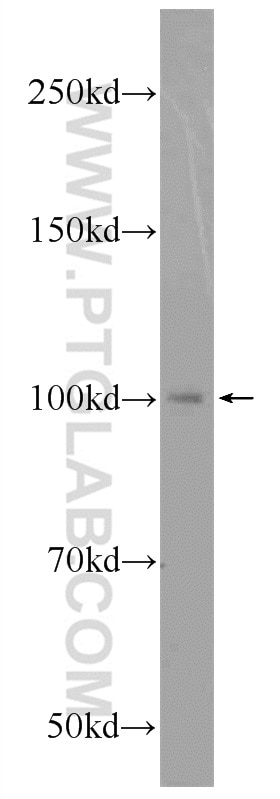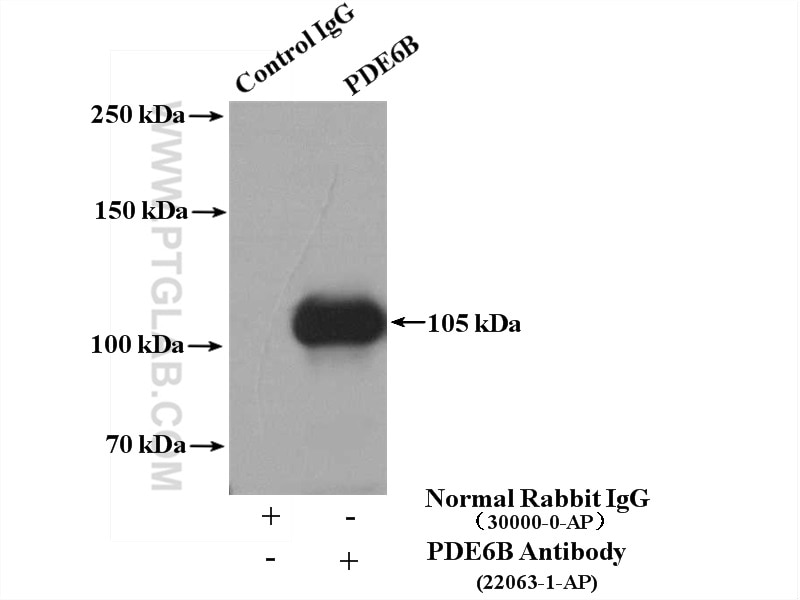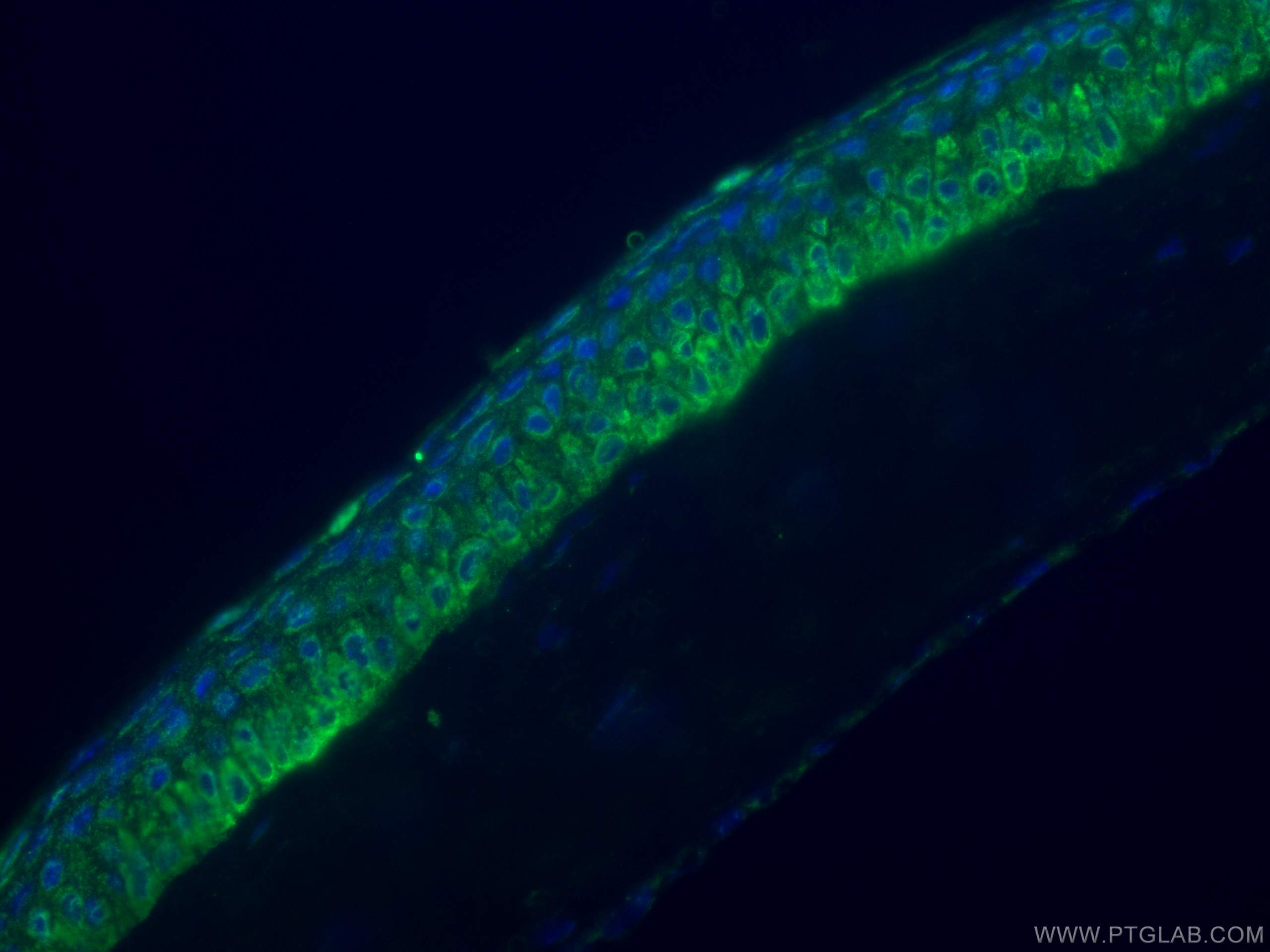Anticorps Polyclonal de lapin anti-PDE6B
PDE6B Polyclonal Antibody for WB, IP, IF, ELISA
Hôte / Isotype
Lapin / IgG
Réactivité testée
Humain, rat, souris et plus (1)
Applications
WB, IHC, IF-P, IP, ELISA
Conjugaison
Non conjugué
N° de cat : 22063-1-AP
Synonymes
Galerie de données de validation
Applications testées
| Résultats positifs en WB | tissu oculaire de souris, cellules A549, tissu oculaire de rat |
| Résultats positifs en IP | cellules Y79 |
| Résultats positifs en IF-P | tissu oculaire de souris, |
Dilution recommandée
| Application | Dilution |
|---|---|
| Western Blot (WB) | WB : 1:500-1:2000 |
| Immunoprécipitation (IP) | IP : 0.5-4.0 ug for 1.0-3.0 mg of total protein lysate |
| Immunofluorescence (IF)-P | IF-P : 1:50-1:500 |
| It is recommended that this reagent should be titrated in each testing system to obtain optimal results. | |
| Sample-dependent, check data in validation data gallery | |
Applications publiées
| WB | See 7 publications below |
| IHC | See 1 publications below |
| IF | See 3 publications below |
Informations sur le produit
22063-1-AP cible PDE6B dans les applications de WB, IHC, IF-P, IP, ELISA et montre une réactivité avec des échantillons Humain, rat, souris
| Réactivité | Humain, rat, souris |
| Réactivité citée | Humain, poisson-zèbre, souris |
| Hôte / Isotype | Lapin / IgG |
| Clonalité | Polyclonal |
| Type | Anticorps |
| Immunogène | PDE6B Protéine recombinante Ag17139 |
| Nom complet | phosphodiesterase 6B, cGMP-specific, rod, beta |
| Masse moléculaire calculée | 854 aa, 98 kDa |
| Poids moléculaire observé | 98 kDa |
| Numéro d’acquisition GenBank | BC000249 |
| Symbole du gène | PDE6B |
| Identification du gène (NCBI) | 5158 |
| Conjugaison | Non conjugué |
| Forme | Liquide |
| Méthode de purification | Purification par affinité contre l'antigène |
| Tampon de stockage | PBS avec azoture de sodium à 0,02 % et glycérol à 50 % pH 7,3 |
| Conditions de stockage | Stocker à -20°C. Stable pendant un an après l'expédition. L'aliquotage n'est pas nécessaire pour le stockage à -20oC Les 20ul contiennent 0,1% de BSA. |
Informations générales
PDE6 is a cGMP-specific PDE family and presents multicomponent enzyme complexes. The rod PDE6 enzyme is comprised of two catalytic subunits (PDE6A and PDE6B) and it is expressed in human lungs (PMID:20979602). PDE6B(Rod cGMP-specific 3',5'-cyclic phosphodiesterase subunit beta) is also named as PDEB and belongs to the cyclic nucleotide phosphodiesterase family. PDE6B also has a C-terminal CAAX motif for posttranslational processing involving lipidation, proteolysis, and carboxymethylation (PMID:8394243). Defects in PDE6B are the cause of retinitis pigmentosa type 40 (RP40)(PMID:22334370) and congenital stationary night blindness autosomal dominant type 2 (CSNBAD2) (PMID:8075643).
Protocole
| Product Specific Protocols | |
|---|---|
| WB protocol for PDE6B antibody 22063-1-AP | Download protocol |
| IF protocol for PDE6B antibody 22063-1-AP | Download protocol |
| IP protocol for PDE6B antibody 22063-1-AP | Download protocol |
| Standard Protocols | |
|---|---|
| Click here to view our Standard Protocols |
Publications
| Species | Application | Title |
|---|---|---|
Proc Natl Acad Sci U S A Accumulation of non-outer segment proteins in the outer segment underlies photoreceptor degeneration in Bardet-Biedl syndrome. | ||
J Biol Chem Pathogenic Mutations in Retinitis Pigmentosa 2 Predominantly Result in Loss of RP2 Protein Stability in Human and Zebrafish. | ||
J Biol Chem The myosin-tail homology domain of centrosomal protein 290 is essential for protein confinement between the inner and outer segments in photoreceptors. | ||
Dev Biol Luteinizing hormone signaling phosphorylates and activates the cyclic GMP phosphodiesterase PDE5 in mouse ovarian follicles, contributing an additional component to the hormonally induced decrease in cyclic GMP that reinitiates meiosis. | ||
PLoS One Differential requirement of NPHP1 for compartmentalized protein localization during photoreceptor outer segment development and maintenance. |

